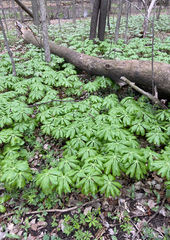Mayapple
Common Name: Mayapple.
Scientific Name: Podophyllum Peltatum.
What to look for? Your initial impression will be an ocean of green leaves floating above the forest floor. As you hike through the woodlands, this vast colony of leaves that resemble umbrellas are very conspicuous. The mayapple is a perennial plant that grows from an underground stem; the root system is long-rhizomatous and fibrous. The umbrella-like or peltate leaves are large and medium to dark green in color. Each leaf is palmate or multi-lobed with from five (5) to nine (9) ovate lobes. These leaves arise from a tall, smooth stem and are attached at the center to the stalk. On Mayapples, only a single flower develops, and only on plants having two (2) leaves (remember each leaf has multiple lobes). The flower is white, with several waxy, spreading petals and the central pistil is green. The fruit or berry is a “may apple” that is egg-shaped and pale yellow in color.
Where can they be found at Carillon Stonegate Pond? Mayapples are found during the Spring on the woodland floors in the many wooded areas around us.
How big are they? Mayapples generally grow to approximately eighteen (18) inches tall and topped with umbrella-like (peltate) leaves. Each leaf is approximately twelve (12) or more inches across. Each leaf is multi-lobed or palmate and has five (5) to nine (9) lobes that are approximately six (6) inches in length and two (2) inches across. The flowerhead is about two (2) inches across.
Where do they grow and thrive? The native Mayapple is a common plant that occurs in the eastern half of the U.S., including across Illinois, and in southern / eastern Canada. It is found primarily in deciduous woodlands, open woodlands, small woodland openings, savannas, and edges of hillside seeps in wooded areas.
When do they bloom? The Mayapple flowers from late March to June – which is why they are called “May” apple.
Do birds, insects or other wildlife associate with this plant? Bumblebees and other long-tongued bees cross-pollinate the flowers of Mayapples. Due to its bitter taste as well as its poisonous qualities, foliage of Mayapple is avoided by mammalian herbivores. The fully ripe berries are edible and eaten by box turtles and by some mammals.
Interesting Facts About Mayapples:
-
The common name refers to the May blooming of its apple-blossom-like flower.
-
Other common names are Mandrake, May-Apple, and May Apple.
-
There is no other plant within the state of Illinois that resembles it; the only other species in the genus Podophyllum occurs in Asia.
For more information on the Mayapple and sources of information used in this blog (these are several of the sources that I am using to learn as I blog), please visit Illinois Wildflowers, Minnesota Wildflowers, Missouri Department of Conservation, and University of Wisconsin Horticultural Extension.
The Carillon at Stonegate community is very fortunate to have a variety of wetland, forest and prairie environments conducive to a variety of birds and other wildlife, insects and plants. Our community and the Kane County Forest Preserve do an exceptional job in maintaining this natural environment – both for the benefit of the birds and wildlife and for our residents to enjoy.
Take a hike and see what you can find – and identify!














